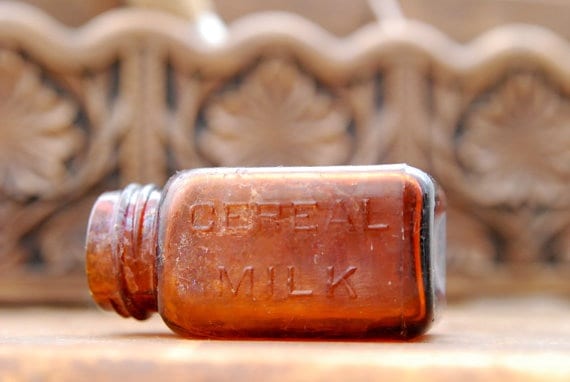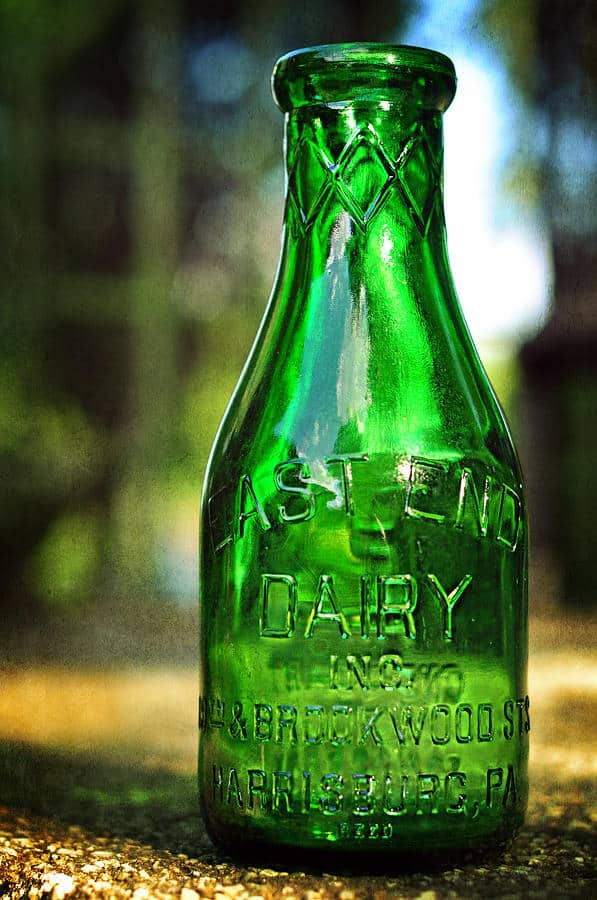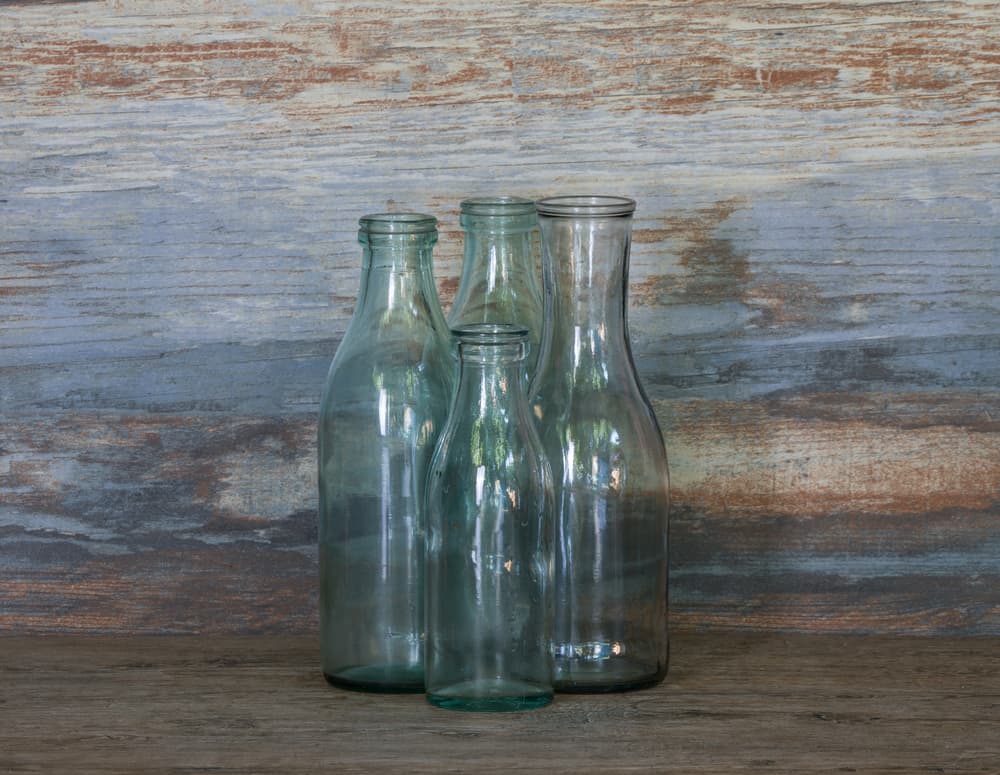For decades, we relied on them to store and keep our milk fresh. And now? Now they can be just as useful – and sell for a small fortune at auction.
With thousands of different bottles made over 100 years, milk bottles are incredibly diverse and easy to collect. And everyone across America has a few in their fridge or gathering dust on a pantry shelf.
So clean out your vintage bottles! Polish them until they sparkle, and join us on a journey to see if your milk bottles are valuable antiques or not.
Table of Contents
How can you tell how old a milk bottle is?
Generally speaking, the older the antique, the more valuable it often is. Here are some useful ways to tell your milk bottle’s age.
Know your timeframes
The first patent for a glass milk bottle production dates to 1874 in the USA, though there is evidence of some experimental production before this.
Bottles were mass-produced until the 1960s when cartons became the popular container.
Pontil marks
American milk bottles were made after 1870, about the time mouth-blown glass was becoming obsolete. There won’t be any pontil marks (scars) from where the glass bottle was removed from the rod, because milk bottles would be machine-made.
If your milk bottle does have a scar, it’s an experimental bottle dated before the milk bottle patent.
Seams
Seams are like the tree rings of milk bottles and can be used to tell you how and when the bottle was made.
Don’t mistake seams for damage – they were an integral part of bottle making. They showed where the molds connected to cast the bottle and were usually found either around the bottle’s base or from the top traveling down the side.
Mold seams made mass-production possible and often included dates, plant codes, or mold numbers – making identification very easy
Shape
Although some milk bottles had specialized patents to experiment with shape, there are generally two distinct milk bottle shapes you should recognize, specifically at the bottom of the bottle.
- Round bottom: this dates your milk bottle to being made before the 1930s.
- Square bottom: More popular in the 1940s and onwards.
Color
Virtually all milk bottles were made of clear glass. You should treat differently colored bottles with extreme caution – they could be reproductions. There are rare instances of different colored glass, namely:

- Amber bottles are most commonly found in the 1930s, usually holding buttermilk and chocolate milk. It was thought the color protected the milk from sunlight.

- Green bottles are uncommon, thought to have only been used to store festive things like eggnog.
- Ruby red & cobalt blue are virtually non-existent. The only known bottles made using these colors were prototypes made by the Hotel Sherman Inn in the 1950s.
Old milk bottle identification
Selling antiques requires you to provide as much information about your prized procession, to highlight its value to potential buyers.
Luckily, milk bottoms have a series of specific marks that can help you identify who made it, when, and where.
Maker’s marks
Maker’s marks are very common in glassware, and usually took the form of logos, branding, or some sort of label that identified who made it.
Milk bottles were constantly collected and reused. Companies spent a great deal of effort embossing their bottles with branding to aid in collecting their bottles and prevent competitors from using them.
These maker’s marks can be a name, logo, or initials embossed on the glass. Bottles with the word ‘Store’ were sold to retail shops, and not used for home delivery.
A complete database of bottle makers and their trademarks can be found here.
Label
After 1933, labels replaced embossing. Labels had some clear advantages over the embossing
- They were much cheaper to make and to apply to the glass.
- Added much-needed color and creativity to advertising.
Well-preserved labels can add huge value and authenticity to milk bottles.
Patents: Special designs
One of the more interesting parts of milk bottle history is the amount of patents companies took out to copyright their signature designs and bottles.
If your bottle has a distinct shape, it more than likely has a patent to it. These patents can tell you who made the bottle, when, and where.
- Baby shaped bottles from 1935.
- ‘Cop-shaped’ bottles from 1937.
- Square bottom bottles were patented first in 1941.
How do I know if my old bottles are worth money?
Specific factors can make or break the value of your vintage milk bottles.
Condition
Condition is the primary way to value any antique, especially milk bottles. Mint condition will always fetch the highest price.
Although milk bottles were durable and made to last, any chips, cracks or scratches can devalue your bottle. If your milk bottles came with special lids or tops, they should come included. Labels should be clear and in good condition, too.
Location matters
People collect milk bottles for a variety of reasons. And despite their signature look, many are motivated to collect memorabilia from their hometown or state.
Milk bottles with clear indications of where they were made will be highly sought after by local bottle collectors.
Special collector editions
Some milk bottles have extra historical significance or are incredibly rare to find.
These include:
- War-time milk bottles, complete with slogans on their labels.
- Bottles fashioned after characters like Mickey Mouse, and Hopalong Cassidy often rise in popularity
- Old glass bottles like Thatcher brand milk bottles
Real or Fake?
Speaking of unique collectibles,s you should always remain cautious when buying war and cartoon-focused bottles. These are prone to forgeries and modern reproductions.
Check that the bottle has appropriate markings that place it at the correct date, e.g. maker’s marks, and mold seams relevant to the period.
If in doubt, ensure you can examine the bottle closely in person before buying. Photographs can be very misleading.
Examine Current Pricing
To get a current market value on your milk bottle, the simplest most effective thing you can do is check auction prices.
This database of auction sales shows just how varied milk bottles are worth. The highest price a set fetched was an impressive $3,850. The lowest was a set of bottle tags for $2.
Where to buy and sell milk bottles
The Federation of Historical Botte Collectors has a bank of information on future conventions, trade shows, and markets where you buy, trade, and sell valuable milk bottles.
Auction sites like eBay and Etsy are two of the most popular auction sites, with new listings posted every day.

I have a 1 qt milk bottle in great condition from W.M, Barton owner in Birmingham Al. is it worth anything? Barton Dairy.
I have two glass Lawsons milk bottles with metal carrier are they worth anything?
I have a milk bottle registered sealed January 11 1914 one quart is it a antique
If it’s over 100 years it’s considered antique
I dug up a thatcher MFC MILK Bottle, trying to find the value of it.
I’m looking for a Robert H Aspinall dairy milk bottle from Weston WV.
He was my great grandfather.